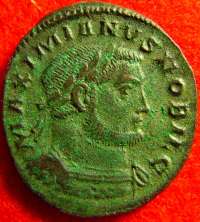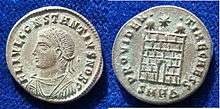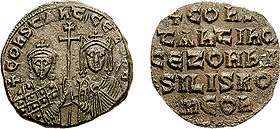Follis
The follis (plural folles; Italian: follaro, Arabic: fels ,فلس) was a type of coin in the Roman and Byzantine traditions.

Roman coin

In the past the word 'follis' was used to describe a large bronze Roman coin introduced in about 294 (the actual name of this coin is unknown [1]) at the time of the coinage reform of Diocletian. It weighed about 10 grams and was about 4% silver, mostly as a thin layer on the surface. However, later studies have shown that this is wrong, and that this coin may have been known as a 'nummus'. The word follis means bag (usually made of leather) in Latin, and there is evidence that this term was used in antiquity for a sealed bag containing a specific amount of coinage. It has also been suggested that the coin was named Follis because of the ancient Greek word "φολίς" meaning a thin layer of metal (cf. Latin folium, "leaf") which covers the surface of various objects, since originally, this coin had a thin layer of silver on top. The 'follis' of Diocletian, despite efforts to enforce prices with the Edict on Maximum Prices (301), was revalued and reduced as time passed. By the time of Constantine, it was smaller and barely contained any silver. A series of Constantinian bronzes was introduced in the mid-4th century, although the specific denominations are unclear and debated by historians and numismatists. They are referred to as AE1, AE2, AE3 and AE4, with the former being the largest (near 27 mm) and the latter the smallest (averaging 15 mm) in diameter. Namely:
| AE1 | AE2 | AE3 | AE4 |
|---|---|---|---|
| over 25 mm | 21 – 25 mm | 17 – 21 mm | under 17 mm |
Fourth century folles represent the largest category of coin finds in the United Kingdom.[2]
Byzantine coin


The follis was reintroduced as a large bronze coin (40 nummi) in 498, with the coinage reform of Anastasius, which included a series of bronze denominations with their values marked in Greek numerals. A 40 nummi coin of Anastasius is depicted on the obverse of the Macedonian 50 denars banknote, issued in 1996.[3]
The fals (a corruption of follis) was a bronze coin issued by the Umayyad and Abbasid caliphates beginning in the late 8th century, initially as imitations of the Byzantine follis.
See also
- Trifollaro, a medieval coin worth 3 folles
- Fals, Copper coin of Umayyads and Abbasids
- Falus, former Moroccan coin
- Fils, modern subdivision of certain Arab currencies
References
- Describing ancient coins Archived 6 October 2006 at the Wayback Machine — accessed on 5 November 2011
- An introduction to Roman coins — accessed on 13 January 2014
- National Bank of the Republic of Macedonia. Macedonian currency. Banknotes in circulation: 50 Denars Archived 29 March 2008 at the Wayback Machine. — accessed on 30 March 2009.
Sources
| Wikimedia Commons has media related to Follis. |
- Grierson, Philip (1999), Byzantine coinage (PDF), Dumbarton Oaks, ISBN 978-0-88402-274-9, archived from the original (PDF) on 13 June 2010
- Hendy, Michael F. (1985), Studies in the Byzantine Monetary Economy c.300–1450, Cambridge University Press, ISBN 0-521-24715-2
- Kazhdan, Alexander, ed. (1991), Oxford Dictionary of Byzantium, Oxford University Press, ISBN 978-0-19-504652-6
External links
- A close look at a follis by Doug Smith
- Follis Coin Catalog information and details
- Article from Forum coins